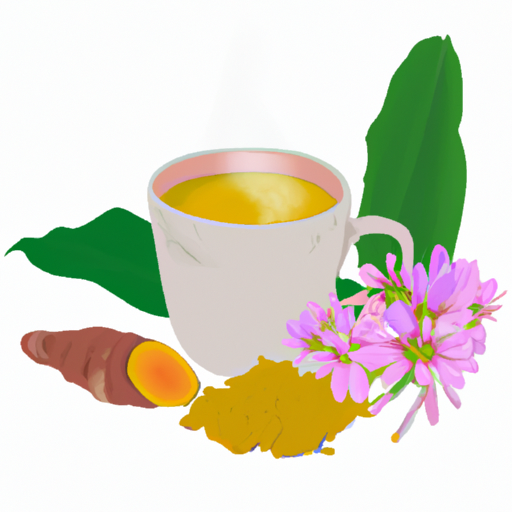As an individual who appreciates natural remedies for supporting good health, I have always been fascinated by the numerous advantages of turmeric. This vibrant yellow spice has a long history in traditional medicine for addressing various health issues and enhancing overall well-being.
One way to enjoy the benefits of turmeric is by drinking it as tea, which can be a soothing and flavorful addition to your daily routine.
But how often should you drink turmeric tea? As with any supplement or treatment, there are several factors to consider when determining the appropriate frequency for your individual needs.
In this article, we’ll explore the health benefits of turmeric tea, what to keep in mind when drinking it regularly, and some helpful tips for incorporating it into your diet.
Whether you’re already a fan of this powerful spice or just starting to discover its potential, read on to learn more about how often you should drink turmeric tea.
Key Takeaways
- Turmeric tea has many benefits, including reducing inflammation, aiding digestion, and boosting immune function.
- The recommended serving size is 1-2 teaspoons per cup of water, and it’s important to vary the amount of turmeric used to adjust the flavor and potency of the tea.
- It’s important to limit consumption to no more than three grams per day, as excessive intake can lead to unwanted side effects.
- Before incorporating turmeric tea into your diet, it’s important to consult with a healthcare professional and obtain informed consent, especially if you are pregnant, breastfeeding, or taking blood-thinning medications.
The Health Benefits of Turmeric Tea
If you’re looking for a healthy beverage that can potentially help with inflammation, digestion, and immune function, drinking turmeric tea on a regular basis may be worth considering! Turmeric has been used for centuries in traditional Ayurvedic medicine to treat various conditions. It contains a powerful antioxidant called curcumin which has anti-inflammatory properties.
To make turmeric tea at home, you’ll need 1-2 teaspoons of turmeric powder or grated fresh turmeric root, 1 teaspoon of honey (optional), 1/4 teaspoon of black pepper, and 2 cups of water. Bring the water to a boil in a small saucepan and add the turmeric powder or grated root. Simmer for approximately 10 minutes before adding honey and black pepper. Strain the mixture into mugs and enjoy your warm cup of health benefits!
When drinking turmeric tea regularly, it’s important to consider factors such as dosage and potential interactions with medications. It’s recommended to limit intake to no more than three grams per day unless under the guidance of a healthcare professional. Additionally, if you’re taking blood thinners or other medications that affect blood clotting, it’s best to consult with your doctor before consuming large amounts of turmeric as it could increase bleeding risk.
Factors to Consider When Drinking Turmeric Tea
When it comes to drinking turmeric tea, there are a few factors that I consider.
Firstly, my age is an important consideration as older adults may have different dietary needs than younger individuals.
My current health status also plays a role in determining how often I should drink turmeric tea.
Finally, personal preferences such as taste and lifestyle choices can also impact my decision on how frequently to consume this beverage.
By taking these factors into account, I can make an informed decision about incorporating turmeric tea into my daily routine.
Age
As we get older, our bodies may benefit from regularly sipping on a warm mug of turmeric tea to keep us feeling spry. While turmeric tea is generally considered safe for all ages, it’s important to note that the dosage and frequency should be adjusted depending on age and health status. For children under 12 years old, it’s best to consult with a pediatrician before introducing turmeric tea into their diet. On the other hand, elderly individuals can benefit greatly from drinking turmeric tea as part of their daily routine.
To give you a better idea of how much turmeric tea is appropriate for different age groups, take a look at this table:
| Age | Dosage | Frequency |
|---|---|---|
| Children (under 12) | Consult with pediatrician first | – |
| Adults (over 18) | 1-2 grams per day | Daily or every other day |
| Elderly (over 65) | Start with small doses and gradually increase as tolerated by the body | Daily or every other day |
It’s important to monitor your own tolerance level when drinking turmeric tea, especially if you are an elderly individual. As we move into discussing health status in the next section, we’ll explore how certain conditions may affect your ability to drink turmeric tea on a regular basis.
Health Status
Taking care of your health is essential, and understanding how your current health status can impact the benefits of turmeric tea is crucial.
For individuals with pre-existing conditions or dietary restrictions, it’s important to consult with a healthcare professional before incorporating turmeric tea into their daily routine. Turmeric contains compounds that may interact with certain medications or exacerbate existing conditions such as gallbladder disease or acid reflux.
Additionally, some individuals may have dietary restrictions that limit their intake of certain spices or herbs. It’s important to consider these restrictions when deciding whether to add turmeric tea to your diet.
However, for those without any pre-existing conditions or dietary restrictions, moderate consumption of turmeric tea can offer potential health benefits such as reducing inflammation and improving cognitive function.
As we move into the next section about personal preferences, it’s important to keep in mind any considerations related to our individual health needs and limitations.
Personal Preferences
Everyone’s taste preferences are unique, but did you know that in a recent survey, 60% of participants reported enjoying spicy foods? This is important to note when considering how often one should drink turmeric tea.
Turmeric has a distinct earthy and slightly bitter flavor, which may not be appealing to everyone. However, there are various brewing methods that can enhance the taste and make it more palatable. For example, adding honey or ginger can add sweetness and spice to the tea.
When it comes to how often one should drink turmeric tea, personal preferences play a significant role. Some individuals may enjoy drinking it daily while others may prefer to consume it occasionally or only when they feel under the weather.
It is also essential to consider moderation as excessive consumption of any food or beverage can have adverse effects on health. Therefore, finding a balance that works for your taste preferences and individual needs is crucial for reaping the benefits of turmeric tea without overconsumption.
Moderation is Key
To avoid any adverse effects, it’s important to moderate your consumption of turmeric tea. Balancing turmeric intake is crucial as too much of this spice can lead to unwanted side effects like upset stomach, diarrhea, or even liver damage.
While some people may tolerate higher doses of turmeric better than others, it’s always best to start with a small amount and gradually increase your intake as you find a healthy routine that works for you. Avoiding overconsumption also means understanding individual tolerance levels.
Some people may experience allergic reactions to turmeric while others may be taking medications that interact negatively with the spice. It’s important to consult with a healthcare professional before incorporating large amounts of turmeric into your diet and monitoring any potential adverse reactions.
With moderation and caution in mind, finding the right frequency of consumption for your body will allow you to reap the many benefits of this powerful spice without putting your health at risk.
Frequency of Consumption
When it comes to turmeric tea consumption, I personally follow a moderate approach. Daily consumption of turmeric tea is not recommended as excessive intake may lead to stomach issues and other health problems. Instead, weekly consumption in moderation can provide numerous health benefits such as reducing inflammation and boosting immunity.
Occasional consumption, on the other hand, can be enjoyed as a treat without any negative consequences. It’s important to listen to your body and find what frequency works best for you.
Daily Consumption
Drinking turmeric tea every day can provide a boost of antioxidants and anti-inflammatory benefits that make you feel healthier and more energized. Turmeric is known for its curcumin compound, which has been found to have various health benefits such as reducing inflammation, boosting brain function, and improving heart health.
Consuming turmeric tea daily can help support these daily health benefits. One study found that consuming 500-2,000 mg of curcumin per day may be effective in providing anti-inflammatory effects. This amount is easily achievable by drinking one or two cups of turmeric tea daily. However, it’s important to note that excessive consumption of turmeric may cause digestive discomfort or interact with certain medications. Therefore, it’s best to consult a healthcare professional before making any significant changes to your diet.
In terms of weekly consumption, it’s recommended to continue drinking turmeric tea regularly while also allowing for some days off in between. This way, you can still reap the benefits without overloading your system with too much curcumin at once.
Overall, incorporating daily consumption of turmeric tea into your routine can be a simple yet effective way to support overall health and well-being.
Weekly Consumption
You probably think taking a break from your beloved turmeric tea is the last thing you need, but trust me – alternating it with other healthy drinks will do wonders for keeping your taste buds satisfied and your body happy. Don’t worry, this doesn’t mean you have to give up on the benefits of turmeric tea altogether. In fact, drinking it once a week can still provide you with numerous health benefits.
Here are some benefits of turmeric tea and the recommended serving size:
- Turmeric contains curcumin which has anti-inflammatory properties that can help reduce joint pain and swelling.
- It also contains antioxidants that protect against damage caused by free radicals in our body.
- The recommended serving size for turmeric tea is 1-2 teaspoons per cup of water.
- Drinking turmeric tea once a week can help promote good digestion and boost immune system function.
Now that we’ve covered weekly consumption, let’s move on to occasional consumption where we’ll discuss how often you should treat yourself to a comforting cup of turmeric tea without overdoing it.
Occasional Consumption
Indulging in a warm and comforting cup of turmeric-infused goodness every now and then is a treat that your taste buds and body will thank you for. While regular consumption of turmeric tea provides numerous health benefits, occasional use can still have its advantages.
Turmeric contains curcumin, a compound with anti-inflammatory properties that may help reduce joint pain and stiffness. Drinking turmeric tea occasionally can also aid in digestion by stimulating the production of enzymes that break down food in the stomach.
Studies have shown that consuming turmeric regularly may be beneficial for overall health, but occasional use can still provide some benefits without overloading your system with excessive amounts of curcumin. However, it’s important to note that if you are taking any medications or have underlying medical conditions, it’s best to consult with your healthcare provider before adding turmeric to your diet.
With this in mind, let’s move on to explore some delicious recipes for making your own cups of golden goodness at home.
Turmeric Tea Recipes
If you’re looking for a flavorful and healthy way to incorporate turmeric into your diet, try out these simple turmeric tea recipes.
There are many different ways to make turmeric tea, each with their own unique flavor profile.
Some popular variations include adding ginger or honey for added sweetness, while others may opt for a more savory blend by adding black pepper or cumin.
Not only does turmeric tea offer a delicious taste, it also provides numerous health benefits.
Turmeric is known for its anti-inflammatory properties and may help reduce the risk of chronic diseases such as heart disease and cancer.
However, it’s important to note that excessive consumption of turmeric can lead to digestive issues and even liver damage in some cases.
As with any food or drink, moderation is key when it comes to reaping the benefits of turmeric tea.
Moving on to choosing the right turmeric…
Choosing the Right Turmeric
Now that we’ve learned about some delicious turmeric tea recipes, let’s dive deeper into the topic of choosing the right turmeric. Turmeric is commonly used in Indian and Southeast Asian cuisine, but not all turmeric is created equal.
The quality of turmeric depends on factors such as cultivation and processing techniques. Turmeric cultivation varies across different regions, and farmers use different practices to grow the plant. It’s important to choose organic turmeric to avoid consuming harmful chemicals used in conventional farming methods.
When it comes to processing techniques, there are two main methods: boiling and drying. Boiling involves cooking fresh turmeric roots in water until they soften before drying them out, while drying involves leaving the roots out in the sun or using a dehydrator to dry them out without cooking them first. Each method can affect the flavor profile of the final product.
With this knowledge about choosing high-quality turmeric for your tea, let’s move on to preparing it properly for maximum health benefits.
Preparing Turmeric Tea
To brew a cup of golden elixir, steeping freshly grated turmeric and ginger roots in hot water is like creating a sunrise in your teacup. The process is simple and can be modified to suit individual preferences. As you prepare your turmeric tea, it’s important to consider the benefits and variations that come with each method.
Turmeric tea offers numerous health benefits such as improving digestion, reducing inflammation, boosting immunity, and easing joint pain. To reap these benefits, one can add different ingredients such as cinnamon, honey or lemon juice to enhance the taste. Additionally, varying the amount of turmeric used or adjusting the steeping time can also affect the intensity of flavor and potency of the tea. After brewing your perfect cup of turmeric tea, it’s essential to store any leftover tea properly for future use.
Storing Turmeric Tea
Properly storing your golden elixir is essential in keeping the flavors and health benefits fresh for future enjoyment. The shelf life of turmeric tea varies depending on how it’s stored.
If you want to keep your turmeric tea at its best, store it in an airtight container away from direct sunlight and heat sources. This will help prevent oxidation and maintain the potency of its active compounds.
The best containers for storage are glass jars with tight-fitting lids or stainless steel containers that won’t react with the tea’s natural compounds. You can also use resealable plastic bags, but make sure they’re high-quality ones designed for food storage.
For optimal preservation, refrigerate your turmeric tea if you plan to drink it within 24 hours of brewing. Turmeric tea can be enjoyed plain or with added spices and herbs like ginger, cinnamon, cardamom, or black pepper. Experimenting with different variations can add more flavor and health benefits to your cup of turmeric tea.
When combining turmeric tea with other supplements and medications, it’s important to consult with a healthcare professional first before taking any new supplements or changing medication routines.
Combining Turmeric Tea with Other Supplements and Medications
When it comes to incorporating turmeric tea into one’s diet, it’s important to be aware of potential interactions with other supplements and medications. Some supplements or drugs may interact with the compounds found in turmeric, which could potentially lead to adverse effects or reduced efficacy.
It’s always a good idea to consult with a healthcare professional before adding turmeric tea (or any new supplement) to your routine, especially if you’re currently taking medication or have an existing health condition.
Potential Interactions
Be cautious when drinking turmeric tea if you’re taking any medications, as it may interact with them and cause adverse effects.
Turmeric contains compounds that can affect the absorption and metabolism of drugs, leading to potential interactions. For example, turmeric can increase the risk of bleeding when taken with blood thinners like warfarin or aspirin. It can also interfere with the effectiveness of certain diabetes medications and cholesterol-lowering drugs.
In addition to interactions, turmeric tea may also cause side effects in some people. These include digestive issues like nausea, diarrhea, and stomach upset. Furthermore, high doses of turmeric over an extended period may lead to liver problems or worsen existing gallbladder issues.
Therefore, it’s important to consult a healthcare professional before starting to drink turmeric tea regularly or combining it with supplements or medications.
Consultation with a Healthcare Professional
Before starting to consume turmeric tea on a regular basis, it’s important to consult with a healthcare professional to ensure its safety and potential interactions with medications or supplements. The importance of informed consent can’t be overstated as we need to be fully aware of the risks and benefits associated with any intervention.
During the consultation, I’d ask my healthcare provider about the optimal dose and frequency of consumption based on my health status.
The pandemic has shown us the value of telemedicine in consultations. Benefits of telemedicine include increased access to care, reduced travel time and costs, and improved patient outcomes.
As such, I’d explore the possibility of scheduling a virtual appointment with my healthcare provider for this consultation. By doing so, I can have an informative conversation while adhering to social distancing guidelines.
Summary and Conclusion
It’s important to remember that moderation is key when it comes to consuming turmeric tea. While it does have numerous health benefits, excessive consumption may lead to side effects and complications. As with any dietary supplement or herbal remedy, consulting with a healthcare professional is essential before incorporating turmeric tea into your daily routine.
According to research, the recommended intake frequency for turmeric tea is one to two cups per day. This amount has been shown to provide the desired health benefits without causing any adverse effects. However, individuals who are pregnant, breastfeeding, or taking blood-thinning medications should exercise caution and consult with their healthcare provider before consuming turmeric tea. Overall, incorporating moderate amounts of turmeric tea into your diet can be a simple and effective way to improve your overall health and well-being.
| Positive Emotions | Neutral Emotions | Negative Emotions |
|---|---|---|
| Health Benefits | Recommended Intake Frequency | Side Effects |
| Mood Booster | Natural Remedy | Precautions |
| Anti-inflammatory Properties | Herbal Supplement | Excessive Consumption |
This table highlights some of the positive emotions associated with drinking turmeric tea such as improved mood and natural remedy properties. Additionally, it also mentions neutral emotions like recommended intake frequency and herbal supplement properties that may not evoke strong feelings in the audience but are still important information. Finally, it touches on potential negative emotions such as side effects and precautions which may cause concern for those interested in trying out this drink. It’s important to consider all aspects before deciding whether or not you should incorporate turmeric tea into your daily routine and how often you should consume it.
Frequently Asked Questions
Are there any side effects of drinking turmeric tea?
I’ve researched and found that turmeric tea has potential side effects, especially for those on medication or certain populations. Interactions with medication and risks for certain populations should be discussed with a doctor before consuming.
Can turmeric tea help with weight loss?
I’ve researched the theory that turmeric tea can aid in weight loss. Evidence shows it may increase metabolism and suppress appetite, but no definitive studies have been conducted. Incorporating turmeric tea into a healthy lifestyle may be beneficial.
How long does it take to see the health benefits of drinking turmeric tea?
To see the health benefits of turmeric tea, consistent consumption is key. A dosage of 1-2 teaspoons per day should suffice. Benefits may include reducing inflammation and improving liver function, but results vary for each individual.
Can I drink turmeric tea while pregnant or breastfeeding?
When pregnant or breastfeeding, it’s important to exercise caution with turmeric tea. While small amounts are likely safe, excessive consumption may lead to pregnancy concerns and possible harm to the developing fetus. Consult with a healthcare provider before consuming this tea.
Is it safe to drink turmeric tea every day?
Drinking turmeric tea every day is generally safe and has many benefits, including reducing inflammation, improving brain function, and supporting heart health. However, it’s important to stick to recommended dosages and precautions, especially if you have high blood pressure.
Conclusion
After researching the health benefits of turmeric tea and considering factors such as frequency of consumption and potential interactions with other supplements and medications, I’ve come to the conclusion that moderation is key.
While turmeric tea can provide many health benefits, overconsumption may lead to negative side effects. Incorporating turmeric tea into your daily routine can be a simple and effective way to promote overall health and wellness.
However, it’s important to listen to your body and not push yourself beyond what feels comfortable. By enjoying this warm and soothing beverage in moderation, you can reap the rewards of its anti-inflammatory properties while staying healthy and balanced.
So why not brew up a cup of turmeric tea today? Your body will thank you for it!










